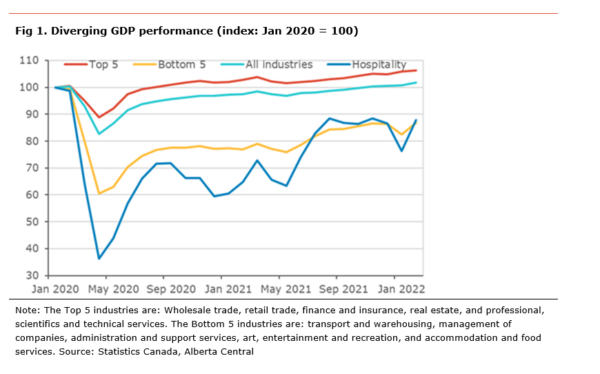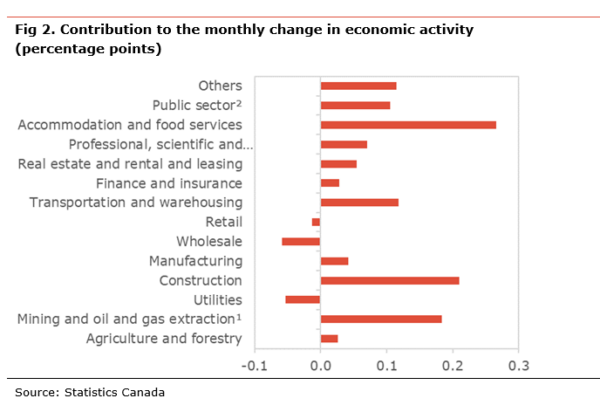Economic insight provided by Alberta Central Chief Economist Charles St-Arnaud.
Bottom line
Today’s release of the GDP for February shows that the hit to the economy from the Omicron wave was minor and short-lived. The data shows that the economy had significant momentum going into the second quarter of 2022, with growth estimated at 5.6% q-o-q ar. in the first quarter.
However, this strength was before the Bank of Canada started to aggressively remove its monetary stimulus, having hiked its policy rate by 75bp so far this year. Moreover, we believe the BoC will continue to aggressively raise interest rates in the coming months, with a 50bp hike in June and July. As a result, some sectors will start to feel the impact of higher interest rates and higher energy prices in the coming months, slowing growth. Moreover, consumers are being squeezed by all sides, with high inflation eroding their purchasing power and high interest rates pushing the cost of servicing record debt levels (see).
For Alberta, the GDP for February shows that a rise in some key industries, especially the oil and gas sector, likely meant that economic activity during the month was stronger than in the rest of the country.
The monthly GDP rose by 1.1% m-o-m in February (+4.5% y-o-y), higher than the preliminary estimate. With this increase, the level of economic activity is currently above its pre-pandemic level by 1.5%.
The details show that only 16 out of 20 industrial sectors posted gains on the month, with hard-to-distance sectors posting the biggest increases as COVID-related restrictions were removed. With the overall level of economic activity being above its pre-COVID level, 11 out of 20 industrial sectors have economic activity above pre-pandemic levels: agriculture, construction, wholesale trade, retail trade, information and culture, finance and insurance, real estate, professional, scientific and technical services, education, health care, and public administration.
Statistics Canada’s preliminary estimate for March suggests growth remained, increasing by 0.5% m-o-m. The advanced information indicates strong increases in activity in client-facing industries, construction and manufacturing. The preliminary estimate points to the economy has grown by 5.6% q-o-q ar. in the first quarter.
The goods-producing side of the economy rose by 1.5% m-o-m in February. All sub-sectors increase on the month, except for a correction in utilities after a strong increase in January (-2.3% m-o-m). Construction activity rose +2.7% m-o-m, due to strong residential building construction. The robust increase in natural resource extraction was broad-based, with stronger activity in mining, oil and gas. Manufacturing was up 0.4% m-o-m.
The services-producing side of the economy increased 0.9% m-o-m. The end of Omicron wave led to a sharp rebound in activity in accommodation and food services (+15.1% m-o-m), and arts, entertainment and recreation (+8.4% m-o-m). A surge in rail transportation and continued normalization in air transportation led to a 3.1% m-o-m increase in transport and warehousing. Continued strong activity in the housing market and a wave of borrowers rushing to lock in their mortgages supported the real estate and leasing sector (+0.4% m-o-m) and finance and insurance (+0.4% m-o-m). There were also solid gains in professional, scientific and technical services (+1.0% m-o-m), public administration (+0.9% m-o-m), and other services (+0.7% m-o-m). However, these gains were partly offset by declining wholesale trade (-1.1% m-o-m) and retail trade (-0.2% m-o-m).
For Alberta, there is no specific data in the report. However, we can make an assessment based on activity in some key industries specific to Alberta. The sharp rise in activity in the agricultural sector, driven primarily by the crop production sector (+4.0% m-o-m), suggests the sector supported growth on the month. Oil and gas extraction and support activity in the oil and gas industry rose by 3.0% m-o-m and 3.1% m-o-m, respectively. Pipeline activity was up 0.5% m-o-m. Overall, the Alberta economy likely grew faster than the rest of the country in February.



Independent Opinion
The views and opinions expressed in this publication are solely and independently those of the author and do not necessarily reflect the views and opinions of any organization or person in any way affiliated with the author including, without limitation, any current or past employers of the author. While reasonable effort was taken to ensure the information and analysis in this publication is accurate, it has been prepared solely for general informational purposes. There are no warranties or representations being provided with respect to the accuracy and completeness of the content in this publication. Nothing in this publication should be construed as providing professional advice on the matters discussed. The author does not assume any liability arising from any form of reliance on this publication.
Alberta Central member credit unions can download a copy of this report in the Members Area here.